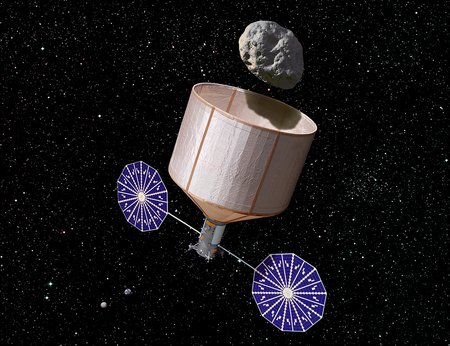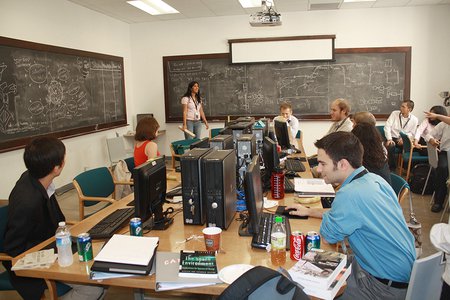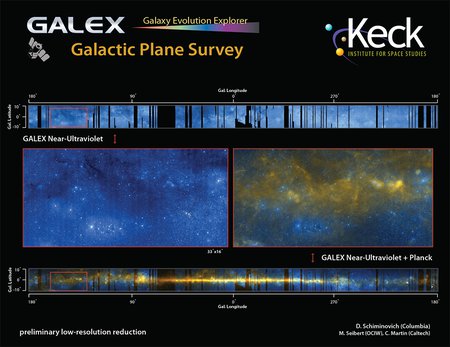NASA is currently exploring options for a mission to capture a small asteroid and haul it into lunar orbit where humans could study it more easily. Meanwhile, NASA's Curiosity rover has been able to determine the age of a rock on Mars for the first time. The space agency is also considering a Centennial Challenge that would encourage civilian engineers to develop airships capable of flying high above the clouds to provide less expensive, more abundant platforms for space telescopes and Earth-observing instruments. And each of the ideas for these activities can be traced back to a workshop put on by the Keck Institute for Space Studies (KISS) at Caltech.
Established in 2008 with funding from the W. M. Keck Foundation and support from JPL, KISS was created to develop revolutionary concepts and technology for future space missions by taking advantage of opportunities for increased collaboration between researchers on campus and at JPL. Importantly, it would do that operating not as a center with a set group of member scientists and engineers but as a "think and do tank."
The concept is straightforward: bring experts together from around the world to interact and brainstorm intensively on a particular topic (that's the think part of the model), then provide follow-up resources to fund any promising ideas that come out of those meetings (that's the do).
"It's deceptively simple," says Tom Prince, KISS's director and a professor of physics at Caltech. "But if you think about it, it doesn't happen much in academia. People might get together to meet, but then nothing happens. There's no 'do,' if you will. I think our model offers a very productive way of doing things."
How It Works
Once a year, KISS solicits proposals for new workshops—in 2014, it funded seven topics ranging from new ways of detecting changing landscapes on Earth and other bodies to the possibility of using adaptable space structures to improve operating conditions for other space assets. Proposals typically come from teams of three researchers, including someone from the Caltech campus, someone from JPL, and someone from the external community, who go on to serve as the workshop coleads if the workshop is selected. Over the course of the year, the leads then schedule one or two multiple-day workshops. Later, they are given the opportunity to propose a two-year follow-on study to pursue any great ideas that came out of the brainstorming.
In the case of the asteroid redirect mission, a small group of researchers proposed a workshop on the topic in 2010. Despite some reasonable skepticism, the KISS steering committee gave them the go-ahead for the workshops, which were held in September 2011 and February 2012. After lively and fruitful discussions and interactions, the workshop participants were able in April 2012 to publish a report saying that such an asteroid-snagging mission was feasible. By late 2012 and early 2013, NASA had tasked JPL with conducting an additional feasibility study, in collaboration with the Glenn Research Center and supported by several other NASA centers. That study found that the mission was indeed doable. When the NASA budget request came out in April 2013, it included funding for the early phases of planning such a mission.
But before an asteroid can be captured, one must be targeted. Therefore, following the workshop phase, KISS provided technical funding for the development of asteroid-hunting software that is now operating with the intermediate Palomar Transient Factory camera on the Samuel Oschin Telescope at Palomar Observatory. The program searches through images of the night sky that are taken every 90 seconds, looking for small, near-Earth asteroids streaking by. The asteroids it identifies could be targets for NASA's mission. Their detection also improves scientific understanding of this class of object, of which there are thought to be roughly one billion in the range of three to eight meters in diameter.
The asteroid redirect mission might be the KISS study with the highest public profile, but it is certainly not the only one that has yielded an innovative idea. Here are a few others:
- NASA's InSight Mars lander, which will land on the red planet in 2016, will use a seismometer to study the interior of Mars—an idea discussed extensively at a KISS workshop in 2010 on innovative approaches to planetary seismology.
- The Centennial Challenge that NASA is currently putting together was a suggestion that came out of a 2013 KISS study on the topic of stratospheric airships and the science that they might enable. The New York Times recently featured the notion of airships, noting that "Keck studies carry substantial weight with NASA."
- Caltech geochemist Ken Farley first became interested in geochronology, or the dating of rocks, on other planetary bodies in 2009 when he attended a KISS workshop on Mars stratigraphy. He realized then that he might be able to adapt some of his work on terrestrial geochronology to such studies in space. Fast forward to 2013: Farley and his colleagues used the Curiosity rover to determine the age of a rock on Mars for the first time.
- During a KISS workshop in 2010 about the universe's first billion years, attendees came up with two novel ways of probing that formative period. Participants arrived thinking they were going to problem-solve ways of gathering measurements of the hydrogen line—a prominent line in radio observations centered at 21-centimeter wavelengths. That has been the standard approach to studying the period when the first structures in the universe began forming. However, following workshop discussions, the participants decided that it should also be possible to learn about those first billion years from measurements of carbon monoxide and ionized carbon. KISS is now funding the development of telescopes to pursue both lines of research.
New Digs Keep the Creative Juices Flowing
One of the keys to KISS's success lies in the institute's emphasis on interactivity. Bethany Ehlmann, an assistant professor of planetary science at Caltech and a research scientist at JPL, has participated in and led several KISS workshops and sits on its steering committee. "KISS workshops are structured not like a typical conference where there are formal presentations and poster sessions. It's more freewheeling," she says. "There is about equal time spent on discussion or work in small groups as on listening to presentations. All of this fosters a 'think, do' approach of deeply delving into the nitty-gritty of understanding a problem and then coming up with creative, innovative solutions, working across disciplines to solve those problems."
That emphasis on interactivity is reflected in KISS's new home on campus: the renovated Tolman/Bacher House and a new structure erected next door—a combined complex now known as the Keck Center, honoring the extraordinary long-term support of Caltech by the W. M. Keck Foundation. The center, designed by Lehrer Architects, is being dedicated on September 15.
In working with the architects to redesign the layout of the house and imagine the new structure, KISS specifically considered how the environment might foster interaction and stimulate conversation.
In the new structure, a large airy meeting room, which KISS calls the Think Tank, is ideal for hosting full workshop groups and is also the new meeting location for Caltech's Board of Trustees. Next door, KISS made sure to include smaller spaces suited to different types of interaction—spots where individuals can sit at a desk to do calculations, spaces where two or three people can interact comfortably, and areas (dubbed the Oort Cloud Lounge and the Black Hole Conference Room) where groups of six or so can meet to flesh out ideas.
The Keck Center was recently given LEED (Leadership in Energy and Environmental Design) Platinum certification, the highest level of recognition for sustainability given by the U.S. Green Building Council. The project earned points for stabilizing and restoring the Tolman/Bacher House and for incorporating such details into the new building as abundant natural light, natural ventilation, and the ability to open up the lobby of the new building to take advantage of the complex's indoor and outdoor spaces.
Into the Future
Looking forward, Prince says he hopes that KISS will fund development of an idea that came out of a 2012 workshop to use NASA's recently launched Orbiting Carbon Observatory-2 to measure the fluorescence produced by plants on Earth as a way of quantifying global photosynthesis—a measure of the health of the biosphere.
Beyond that, he says, he is very interested in enhanced interaction between private space companies, such as SpaceX and Orbital Sciences Corporation; government; and academia. "That can be a very powerful grouping, if it all works together," he says. He notes that Caltech recently convened a group of leaders from all three sectors, forming a Space Innovation Council that will help advise the Institute on space-related matters. "We don't yet know how KISS will fit into the picture with the growing influence of these private companies," says Prince, "but we now have the perfect council to advise us on that."
And, he says, regardless of what happens with these and other ideas, "KISS has already succeeded beyond anything I had expected. I had a private goal from the outset that over time our impact would influence on the order of a billion dollars worth of NASA funding. Little did I think that—with the Asteroid Redirect Mission, if that goes, and the 2016 lander—we'd already have an impact as great as we have."
 Illustration of an asteroid retrieval spacecraft in the process of capturing a 7-meter, 500-ton asteroid. KISS led an asteroid retrieval mission study in 2011–12 to investigate the feasibility of robotically capturing and returning an entire near-Earth asteroid to the vicinity of the Earth/Moon system for scientific investigation.
Credit: Rick Sternbach / Keck Institute for Space Studies
Illustration of an asteroid retrieval spacecraft in the process of capturing a 7-meter, 500-ton asteroid. KISS led an asteroid retrieval mission study in 2011–12 to investigate the feasibility of robotically capturing and returning an entire near-Earth asteroid to the vicinity of the Earth/Moon system for scientific investigation.
Credit: Rick Sternbach / Keck Institute for Space Studies
 An artistic concept of the NASA Mars lander known as InSight (Interior Exploration Using Seismic Investigations, Geodesy and Heat Transport). This mission is scheduled to launch in March 2016, and will investigate processes that formed and shaped Mars, ultimately helping scientists better understand the evolution of our inner solar system's rocky planets.
Credit: NASA / JPL-Caltech
An artistic concept of the NASA Mars lander known as InSight (Interior Exploration Using Seismic Investigations, Geodesy and Heat Transport). This mission is scheduled to launch in March 2016, and will investigate processes that formed and shaped Mars, ultimately helping scientists better understand the evolution of our inner solar system's rocky planets.
Credit: NASA / JPL-Caltech
 Participants in the 2011 Caltech Space Challenge work together to design a manned mission to a Near-Earth Object (NEO). The Caltech Space Challenge brings students from around the globe to the Caltech campus and challenges them to produce a viable design for a specific space mission. Learn about the 2013 and 2015 Challenges.
Credit: Michele Judd / Keck Institute for Space Studies
Participants in the 2011 Caltech Space Challenge work together to design a manned mission to a Near-Earth Object (NEO). The Caltech Space Challenge brings students from around the globe to the Caltech campus and challenges them to produce a viable design for a specific space mission. Learn about the 2013 and 2015 Challenges.
Credit: Michele Judd / Keck Institute for Space Studies
 Rendering of the Autonomous Assembly of a Reconfigurable Space Telescope (AAReST) spacecraft, which is a technology demonstration to show that it might be possible to launch compact spacecraft that can reconfigure themselves in space to form telescopes with large primary apertures. The program is a collaborative effort between Caltech/KISS and the University of Surrey.
Credit: Space Structures Laboratory / Caltech
Rendering of the Autonomous Assembly of a Reconfigurable Space Telescope (AAReST) spacecraft, which is a technology demonstration to show that it might be possible to launch compact spacecraft that can reconfigure themselves in space to form telescopes with large primary apertures. The program is a collaborative effort between Caltech/KISS and the University of Surrey.
Credit: Space Structures Laboratory / Caltech
 An illustration of the newly developed capacity to monitor chlorophyll fluorescence from terrestrial vegetation by satellite. In 2012, KISS led a workshop to improve scientists' ability to pinpoint locations, times, and methods for the exchange of carbon dioxide between the earth and the atmosphere, which will further our understanding of climate change.
Credit: Pat Rawlings / Keck Institute for Space Studies
An illustration of the newly developed capacity to monitor chlorophyll fluorescence from terrestrial vegetation by satellite. In 2012, KISS led a workshop to improve scientists' ability to pinpoint locations, times, and methods for the exchange of carbon dioxide between the earth and the atmosphere, which will further our understanding of climate change.
Credit: Pat Rawlings / Keck Institute for Space Studies
 A conceptual rendering of the Fractionated L5 Space Weather Sentinel constellation mission designed to monitor the region between the solar surface and the Earth. This mission was conceived during a 2012 KISS program held to identify scientific advances made possible by small satellites.
Credit: NASA
A conceptual rendering of the Fractionated L5 Space Weather Sentinel constellation mission designed to monitor the region between the solar surface and the Earth. This mission was conceived during a 2012 KISS program held to identify scientific advances made possible by small satellites.
Credit: NASA
 Illustration of a possible airship observatory that includes a top-mounted telescope and a suite of Earth and atmospheric instruments mounted on the underbelly. In 2013, KISS investigated the potential of a variety of airships to serve as observatories and platforms for science instrumentation for a range of space, atmospheric, and Earth sciences studies.
Credit: Mike Hughes (Eagre Interactive) / Keck Institute for Space Studies
Illustration of a possible airship observatory that includes a top-mounted telescope and a suite of Earth and atmospheric instruments mounted on the underbelly. In 2013, KISS investigated the potential of a variety of airships to serve as observatories and platforms for science instrumentation for a range of space, atmospheric, and Earth sciences studies.
Credit: Mike Hughes (Eagre Interactive) / Keck Institute for Space Studies
 A composite of results from the Galaxy Evolution Explorer (GALEX) mission showing the first complete ultraviolet image of the Milky Way. Launched into orbit by NASA in 2003, GALEX conducted several first-of-a-kind sky surveys that will ultimately help scientists better understand how galaxies like our own Milky Way formed.
Credit: D. Schiminovich (Columbia) / M. Seibert (OCIW) / C. Martin (Caltech)
A composite of results from the Galaxy Evolution Explorer (GALEX) mission showing the first complete ultraviolet image of the Milky Way. Launched into orbit by NASA in 2003, GALEX conducted several first-of-a-kind sky surveys that will ultimately help scientists better understand how galaxies like our own Milky Way formed.
Credit: D. Schiminovich (Columbia) / M. Seibert (OCIW) / C. Martin (Caltech)








